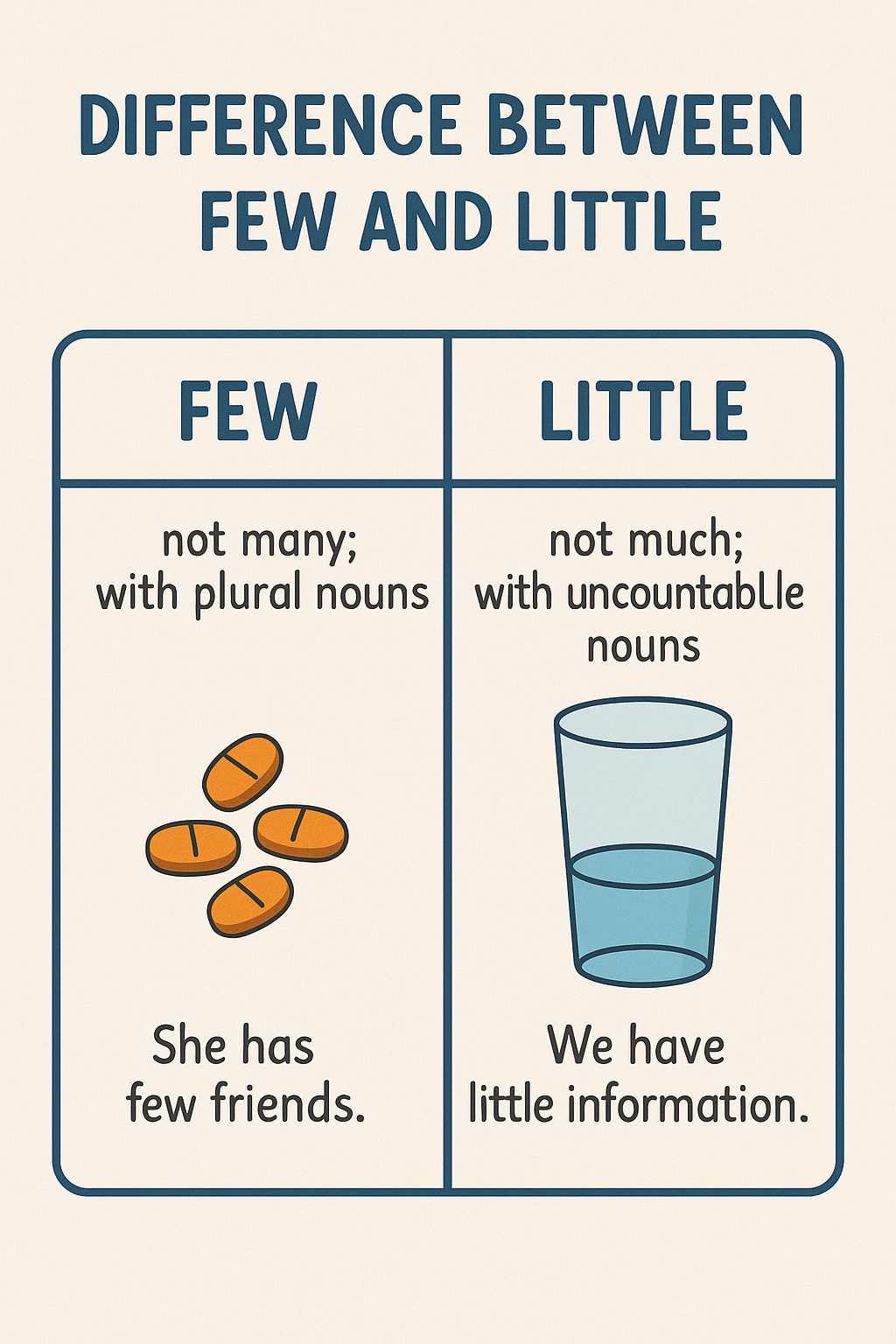Difference Between Few and Little-Grammar Puzzle Solved (33)
Understanding the difference between few and little helps English learners avoid common grammar errors. Although both refer to small quantities, their usage depends entirely on whether the noun is countable or uncountable. Choosing the correct word improves both clarity and correctness.

Use “Few” for Countable Nouns
We use “few” with countable nouns — objects or things that can be counted one by one. These nouns usually appear in the plural form. For instance, when someone says, “He has few friends,” it suggests he doesn’t have many friends, possibly too few.
Examples:
- She made few mistakes in her essay.
- They received few invitations to the event.
- We have few apples left in the basket.
- The teacher gave few instructions before the test.
- He saw few birds during his walk in the forest.
In all cases, “few” implies a negative tone, suggesting not enough or below expectation.
Use “Little” for Uncountable Nouns
“Little” is used with uncountable nouns — substances, abstract ideas, or materials that cannot be counted separately. For example, saying “They have little time” means that time is nearly gone or not sufficient. Additionally, these nouns do not have a plural form. Consequently, “little” often conveys a negative tone, suggesting a lack of something important. Therefore, it is important to identify whether a noun is uncountable before using “little.” In fact, using it incorrectly can confuse the reader. To clarify, words like milk, love, money, and sugar are all uncountable. As a result, they should pair with “little,” not “few.” Thus, the sentence “She has little hope left” is correct, while “She has few hope left” is not.
Examples:
- We have little milk in the fridge.
- He felt little interest in the topic.
- The team showed little progress in the project.
- There is little noise in the quiet room.
- She had little patience during the wait.
Just like “few,” “little” expresses scarcity and often a sense of concern.
Using “A Few” and “A Little” Positively
Adding “a” changes the meaning to a more positive tone. “A few” and “a little” suggest small amounts that are still acceptable.
Examples:
- A few people joined the group late.
- A few questions remained unanswered.
- We still have a little sugar for tea.
- She showed a little kindness to the stranger.
Conclusion
The difference between few and little lies in noun type. “Few” is for countable nouns, while “little” is for uncountable ones. In addition, adding “a” softens the meaning. Learning this rule will help avoid confusion and improve your writing.
James Joyce as a Modernist Writer: https://englishlitnotes.com/2025/05/30/james-joyce/
The Echoing Green by William Blake:
https://englishwithnaeemullahbutt.com/2025/05/10/the-echoing-green-by-william-blake/
Anne Bradstreet’s Biography: https://americanlit.englishlitnotes.com/anne-bradstreet/
For English and American literature and grammar, visit Google: https://www.google.com
Few, A Few, and The Few: https://grammarpuzzlesolved.englishlitnotes.com/few-a-few-and-the-few/
Discover more from Grammar Puzzle Solved by Naeem Ullah Butt
Subscribe to get the latest posts sent to your email.